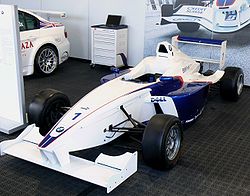Technical information
Formula BMW was what is sometimes referred to as a "slicks and wings" formula, which describes the use of slick tires and downforce-generating wings at the front and rear. The addition of wings results in cornering speeds that are faster than that which is achieved by the wingless Formula Ford cars and comparable to Formula Renault, and provides drivers with valuable first-time experience of the unique characteristics of aerodynamic downforce. Formula BMW was strictly a "control" formula. This term describes a formula in which every major aspect of equipment and suppliers is restricted. Control formulae normally have only one chassis specification, one engine, and single suppliers of tires and fuel. Modifications to the chassis, bodywork and engine are not permitted and this is strictly enforced through scrutineering. In the case of Formula BMW, tuning is restricted to basic adjustment of the gear ratios, suspension, brake balance, and wing angles.[18][19] The engines are sealed to prevent illegal modifications and are serviced by Schnitzer Motorsport.[20] DesignworksUSA, a subsidiary of BMW, led the design of the car in cooperation with the French chassis constructor Mygale, which was responsible for production.[18] The result, designated "FB02", was a compact design, with a carbon-fibre composite tub constructed to the safety standards of the Federation Internationale de l'Automobile (motorsport's world governing body). The bodywork is made from a kevlar composite.[21] At 3.975 m (13.041 ft) in length, it was larger than a Formula Ford 1600, and slightly smaller than a Formula Renault 2000. The engine was sourced from BMW's motorcycle division: it is a near-standard K1200RS motorcycle engine, in an inline four-cylinder configuration, with a capacity of 1171 cc, and a power output of 140 hp (100 kW). Drive is through a single-plate clutch and a six-speed sequential gearbox, produced by Hewland. The complete car weighs 455 kg without fuel and driver. sl

ck tyre (also known as a "racing slick") is a type of tyre that has no tread, used mostly in auto racing. The first production "slick tyre" was developed by M&H Tires in the early 1950s for use in drag racing. By eliminating any grooves cut into the tread, such tyres provide the largest possible contact patch to the road, and maximize traction for any given tyre dimension[citation needed]. Slick tyres are used on road or oval track racing, where steering and braking require maximum traction from each wheel[citation needed], but are typically used on only the driven (powered) wheels in drag racing, where the only concern is maximum traction to put power to the ground[citation needed]. Slick tyres are not suitable for use on common road vehicles, which must be able to operate in all weather conditions. They are used in auto racing where competitors can choose different tyres based on the weather conditions and can often change tyres during a race. Slick tyres provide far more traction than grooved tyres on dry roads[citation needed], due to their greater contact area but typically have far less traction than grooved tyres under wet conditions[citation needed]. Wet roads severely diminish the traction because of aquaplaning due to water trapped between the tyre contact area and the road surface. Grooved tyres are designed to remove water from the contact area through the grooves, thereby maintaining traction even in wet conditions. Since there is no tread, slick tyre tread does not deform too much under load[citation needed]. The reduced deformation allows the tyre to be constructed of softer compounds without excessive overheating and blistering. The softer rubber gives greater adhesion to the road surface, but it also has a lower treadwear rating; i.e. it wears out much more quickly than the harder rubber tyres used for driving on the streets. It is not uncommon for drivers in some autosports to wear out multiple sets of tyres during a single day's driving.